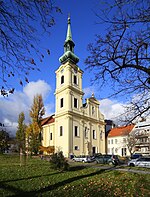Semmelweis Museum of Medical History
1965 establishments in HungaryBaroque architecture in HungaryHistory museums in HungaryHouses completed in 1810Ignaz Semmelweis ... and 6 more
Landmarks in BudapestMedical museumsMuseums established in 1965Museums in BudapestNational museums of HungaryTabán

The Semmelweis Museum, Library and Archive of the History of Medicine (Hungarian: Semmelweis Orvostörténeti Múzeum, Könyvtár és Levéltár) is a museum, library and archive in Budapest, Hungary. It was founded in 1965, and became a department of the Hungarian National Museum in 2017. The museum is located in the 18th-century house where Ignaz Semmelweis was born in 1818. The exhibition covers the development of healthcare in Hungary and the main stages in the history of medicine in Europe.
Excerpt from the Wikipedia article Semmelweis Museum of Medical History (License: CC BY-SA 3.0, Authors, Images).Semmelweis Museum of Medical History
Apród utca, Budapest Tabán
Geographical coordinates (GPS) Address Nearby Places Show on map
Geographical coordinates (GPS)
| Latitude | Longitude |
|---|---|
| N 47.493352 ° | E 19.043211 ° |
Address
Apród utca
Apród utca
1013 Budapest, Tabán
Hungary
Open on Google Maps










